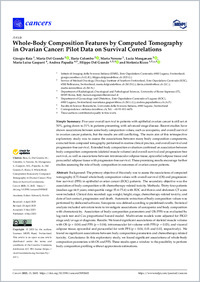Whole-body composition features by computed tomography in ovarian cancer : pilot data on survival correlations
- Raia, Giorgio Istituto di Imaging della Svizzera Italiana (IIMSI), Ente Ospedaliero Cantonale, Lugano, Switzerland
- Del Grande, Maria ORCID Service of Medical Oncology, Oncology Institute of Southern Switzerland, Ente Ospedaliero Cantonale (EOC), Bellinzona, Switzerland
- Colombo, Ilaria ORCID Service of Medical Oncology, Oncology Institute of Southern Switzerland, Ente Ospedaliero Cantonale (EOC), Bellinzona, Switzerland
- Nerone, Marta Service of Medical Oncology, Oncology Institute of Southern Switzerland, Ente Ospedaliero Cantonale (EOC), Bellinzona, Switzerland
- Manganaro, Lucia ORCID Department of Radiological, Oncological and Pathological Sciences, University of Rome Sapienza, Roma, Italy
- Gasparri, Maria Luisa Department of Gynecology and Obstetrics, Ente Ospedaliero Cantonale of Lugano (EOC), Lugano, Switzerland
- Papadia, Andrea Department of Gynecology and Obstetrics, Ente Ospedaliero Cantonale of Lugano (EOC), Lugano, Switzerland - Facoltà di Scienze Biomediche, Università della Svizzera Italiana, Lugano, Switzerland
- Del Grande, Filippo ORCID Istituto di Imaging della Svizzera Italiana (IIMSI), Ente Ospedaliero Cantonale, Lugano, Switzerland - Facoltà di Scienze Biomediche, Università della Svizzera Italiana, Lugano, Switzerland
- Rizzo, Stefania ORCID Istituto di Imaging della Svizzera Italiana (IIMSI), Ente Ospedaliero Cantonale, Lugano, Switzerland - Facoltà di Scienze Biomediche, Università della Svizzera Italiana, Lugano, Switzerland
- 2023
Published in:
- Cancers. - 2023, vol. 15, no. 9, p. 2602
English
Background: The primary objective of this study was to assess the associations of computed tomography (CT)-based whole-body composition values with overall survival (OS) and progression-free survival (PFS) in epithelial ovarian cancer (EOC) patients. The secondary objective was the association of body composition with chemotherapy-related toxicity. Methods: Thirty-four patients (median age 64.9 years; interquartile range 55.4–75.4) with EOC and thorax and abdomen CT scans were included. Clinical data recorded: age; weight; height; stage; chemotherapy-related toxicity; and date of last contact, progression and death. Automatic extraction of body composition values was performed by dedicated software. Sarcopenia was defined according to predefined cutoffs. Statistical analysis included univariate tests to investigate associations of sarcopenia and body composition with chemotoxicity. Association of body composition parameters and OS/PFS was evaluated by log-rank test and Cox proportional hazard model. Multivariate models were adjusted for FIGO stage and/or age at diagnosis. Results: We found significant associations of skeletal muscle volume with OS (p = 0.04) and PFS (p = 0.04); intramuscular fat volume with PFS (p = 0.03); and visceral adipose tissue, epicardial and paracardial fat with PFS (p = 0.04, 0.01 and 0.02, respectively). We found no significant associations between body composition parameters and chemotherapy-related toxicity. Conclusions: In this exploratory study, we found significant associations of whole-body composition parameters with OS and PFS. These results open a window to the possibility to perform body composition profiling without approximate estimations.
- Collections
- Language
-
- English
- Classification
- Medicine
- License
- Open access status
- gold
- Identifiers
-
- DOI 10.3390/cancers15092602
- ARK ark:/12658/srd1326693
- Persistent URL
- https://n2t.net/ark:/12658/srd1326693
Statistics
Document views: 109
File downloads:
- Rizzo_2023_MDPI_cancers: 148
